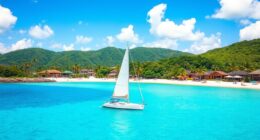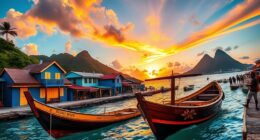The U.S. Virgin Islands have a rich history shaped by indigenous Arawak communities, European colonial powers, and African resilience. You’ll find a legacy of Danish rule, plantation economy, and the progression to U.S. sovereignty that still influences local culture today. Their vibrant identity is reflected in festivals, traditional art, and culinary diversity rooted in African, European, and Caribbean influences. Exploring further reveals how history has inspired a strong sense of cultural pride and self-governance among residents.
Key Takeaways
- The U.S. Virgin Islands have a rich history influenced by Indigenous Arawak peoples, European colonial powers, and the transatlantic slave trade.
- Danish colonization in the 17th century established plantation economies, with colonial architecture reflecting European heritage.
- The islands transitioned from Danish control to U.S. sovereignty in 1917, shaping their political and cultural identity.
- African heritage profoundly influences local music, dance, festivals, and traditions, emphasizing cultural resilience.
- The islands’ vibrant culture is expressed through festivals, art, diverse culinary traditions, and efforts to preserve their historical and cultural heritage.
Indigenous Beginnings and Early European Encounters

The history of the U.S. Virgin Islands begins with early Indigenous peoples. You’d find that around 100 BC, Arawak Indians from South America settled in the Virgin Islands region. These early inhabitants relied on fishing, agriculture, and trading. When European explorers arrived, they encountered a landscape already inhabited and shaped by these indigenous groups. Over time, various European powers—Spain, the Netherlands, Knights of Malta, and England—traded control of the islands, often disrupting local societies. The Dutch first settled Tortola in 1648, but the English replaced them in 1666. Meanwhile, Denmark occupied St. Thomas that same year, establishing colonies for cash crop farming. These early European encounters set the stage for centuries of colonial influence that would forever change the islands’ cultural and social fabric. European colonization significantly impacted the indigenous populations, leading to cultural exchanges and conflicts that shaped the islands’ history.
Colonial Era: Danish Rule and the Plantation Economy

After European powers shifted control among themselves, Denmark established a foothold in the Virgin Islands in the late 17th century, focusing on developing a profitable plantation economy. You find that Danish settlers quickly set up sugar, cotton, and indigo plantations, with sugar becoming the dominant crop by mid-1700s. To sustain this economy, they imported enslaved Africans starting in 1673, relying heavily on their labor. Slave rebellions, such as those on St. John in 1733 and St. Croix in 1848, marked the struggle for freedom. Despite intermittent British occupation between 1801 and 1815, Denmark maintained control. By the late 19th century, the decline of sugar production and emancipation led to economic downturns, shaping the islands’ colonial legacy.
Transition From Danish to U.S. Sovereignty

In 1917, the United States made a strategic move by purchasing the Danish West Indies for $25 million in gold, marking a significant shift in sovereignty. You might notice that this purchase aimed to enhance U.S. security during World War I and expand its strategic presence in the Caribbean. After the transfer, the islands were renamed the Virgin Islands of the United States, and U.S. Navy officials initially managed them. You’ll see that residents were given the option to retain Danish citizenship within a year or automatically become U.S. citizens, which most did by 1927. That same year, the islands officially became an unincorporated U.S. territory. The progression marked the end of Danish control and began a new chapter of American governance, shaping the islands’ political and economic future. Sovereignty transfer was a pivotal moment in the history of the U.S. Virgin Islands.
Political Development and Self-Governance

As the U.S. Virgin Islands shifted from military to civilian control, you see how local governance began to take shape. Efforts to establish political autonomy grew, leading to the creation of local institutions and elected leaders. These developments reflect the territory’s ongoing quest for self-governance within the framework of U.S. oversight. The process also involved the development of local political structures, which laid the foundation for more autonomous decision-making.
Transition to Civil Authority
The changeover from colonial rule to self-governance in the U.S. Virgin Islands marked a pivotal shift. You’ll see this progression unfold through key developments:
- The establishment of local government institutions via the 1936 Organic Act, giving residents some control over internal affairs.
- The election of Melvin H. Evans as the territory’s first governor in 1970, symbolizing political maturation.
- The drafting of a constitution starting in 1976, aiming to formalize self-governance and enhance local authority.
- The gradual transfer of administrative control from U.S. Navy to civilian agencies within the Department of the Interior, empowering residents to influence governance.
This process reflects a steady movement toward greater self-determination while maintaining ties to the United States.
Additionally, the emphasis on topical authority in content development has played a significant role in reinforcing the territory’s political and cultural identity.
Establishment of Local Governance
The establishment of local governance in the U.S. Virgin Islands began with the 1936 Organic Act, which created a legislative council and limited self-rule. Over time, residents pushed for greater control, leading to the 1954 Revised Organic Act, which expanded local authority and established a governor appointed by the U.S. President. In 1970, the territory elected its first governor, Melvin H. Evans, marking a shift toward more autonomous leadership. Efforts to develop a constitution started in 1976, reflecting the territory’s desire for self-governance. Today, the Virgin Islands operate under a local government with an elected legislature and governor, balancing U.S. oversight with local decision-making. This gradual political development underscores the territory’s ongoing pursuit of greater self-determination. Recognizing the importance of self-governance can foster a deeper understanding of the territory’s political evolution.
Political Autonomy Efforts
Have you ever wondered how the U.S. Virgin Islands seek more political autonomy? You’ll find that residents have pushed for increased self-governance through several efforts:
- Advocating for a constitution to define local authority and rights.
- Campaigning for greater legislative powers within the existing territorial framework.
- Supporting moves toward a statehood referendum or independence.
- Building local political institutions that emphasize cultural identity and self-determination.
- The pursuit of political development reflects a desire to strengthen local governance and identity.
While the islands remain U.S. territories, these efforts show a desire to balance federal oversight with local control. Over the years, residents have worked to expand their political voice, aiming for a more autonomous future that respects their unique heritage and needs.
Economic Shifts: From Plantations to Tourism

As the plantation economy declined in the early 20th century, the U.S. shifted focus toward tourism. You’ll notice that, by the 1930s, resorts like Caneel Bay opened, signaling a new economic direction. The Virgin Islands National Park, established in 1956, drew visitors and boosted the industry. Travel restrictions to Cuba in the late 1950s increased U.S. tourism, further transforming the islands’ economy. The table below highlights key milestones:
| Year | Event |
|---|---|
| 1918 | End of sugar production on St. John |
| 1935 | Opening of Caneel Bay Resort |
| 1956 | Creation of Virgin Islands National Park |
Tourism eventually surpassed agriculture, shaping the islands’ identity and economy today. Tourism growth played a significant role in redefining the islands’ economic landscape.
Cultural Heritage and Contemporary Identity

The Virgin Islands’ cultural heritage reflects a rich tapestry woven from indigenous traditions, European influences, African roots, and American connections. You’ll find this diversity alive in daily life, community celebrations, and local art. To understand how this shapes contemporary identity, consider:
- The lasting impact of African music, dance, and festivals celebrating emancipation.
- Danish colonial architecture evident in historic buildings and port towns.
- The significance of Transfer Day and emancipation holidays in preserving historical memory.
- The blending of Caribbean, European, and American cuisines that define local food culture.
- The cultural resilience demonstrated through the preservation of traditional practices and adaptations to modern influences.
This mix fosters a unique, resilient identity that honors past struggles and achievements. Today, the islands celebrate their heritage through festivals, art, and traditions, creating a vibrant cultural landscape that persists amid modern influences.
Frequently Asked Questions
How Did Indigenous Cultures Influence Modern Virgin Islands Traditions?
You can see indigenous cultures influence modern Virgin Islands traditions in music, cuisine, and festivals. Their rhythms and dance styles blend with African and European elements, creating unique local celebrations. Traditional foods incorporate native ingredients, and storytelling preserves indigenous history. You’ll notice these influences during events like Emancipation Day, where cultural pride and indigenous roots are celebrated, connecting past and present in the islands’ vibrant cultural identity.
What Role Did African Slaves Play in Shaping Local Cultural Practices?
African slaves markedly shaped local cultural practices in the Virgin Islands. You’ll notice their influence in music, dance, and festivals, which celebrate emancipation and heritage. Their traditions blend with indigenous and European roots, creating unique Caribbean expressions. You participate in lively festivals, enjoy rhythms like reggae and calypso, and savor cuisine inspired by African flavors. This cultural fusion reflects the resilience and rich history of African descendants in the islands.
How Has Danish Architecture Impacted the Islands’ Urban Landscape Today?
You’ll notice Danish architecture deeply influences the islands’ urban landscape today, especially in Charlotte Amalie. You walk through streets lined with historic buildings, colorful facades, and distinctive colonial-style structures that date back to the Danish period. These buildings add charm and character to the cities, blending European maritime design with local culture. Their preservation highlights the islands’ rich history and continues to attract visitors who appreciate the unique architectural heritage.
What Are the Main Symbols of Virgin Islands Identity and Heritage?
You see the main symbols of Virgin Islands identity in their vibrant festivals, colonial architecture, and historical landmarks like Transfer Day celebrations. You notice the influence of African culture in music, cuisine, and community gatherings, reflecting deep roots in heritage. The beautiful landscapes and national parks also symbolize resilience and natural beauty. Together, these elements celebrate their unique history, blending indigenous, European, African, and American influences into a rich cultural identity.
How Do Current Residents View Their History of Colonial Rule and U.S. Integration?
You likely see your history of colonial rule and U.S. integration as a complex mix of pride and nostalgia. While many appreciate the economic opportunities and stability brought by U.S. governance, you also value the rich cultural heritage from indigenous, African, and European influences. Some residents may feel a desire to preserve local traditions and identity, balancing appreciation for progress with a respect for the islands’ unique historical roots.
Conclusion
As you explore the U.S. Virgin Islands’ vibrant history and culture, you’ll see a tapestry woven with resilience, tradition, and transformation. From indigenous roots to modern-day paradise, these islands are like a living storybook, each chapter adding depth and color. Embrace their spirit, where history’s echoes dance alongside the lively rhythms of today, inviting you to become part of their ongoing story—an enduring symphony of past and present that beckons you to listen and learn.








